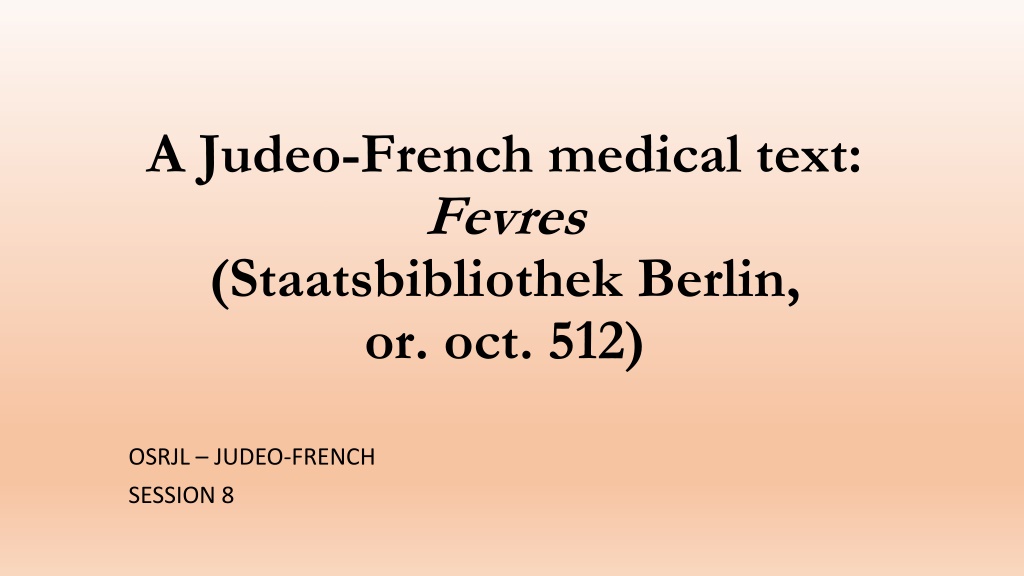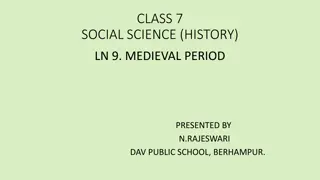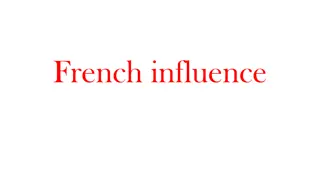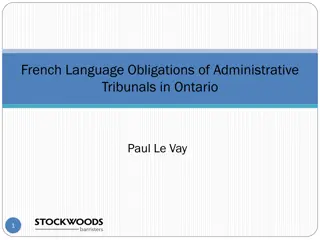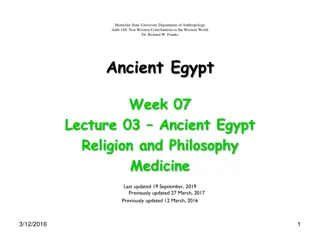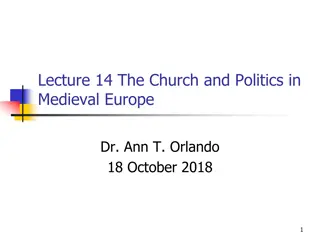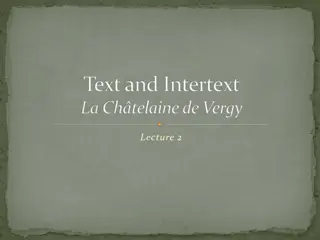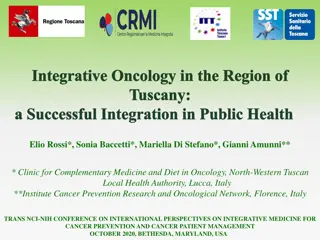Judeo-French Influence on Medieval Medicine in Europe
Explore the unique intersection of Judeo-French language and medieval medicine in Europe. Discover the exceptional Judeo-French medical text "Fevres" and its secular scientific focus. Learn about Jewish scholars' contributions to medical knowledge dissemination in Tsarfat (Medieval France) and their adaptation of Anglo-Norman translations from Latin sources. Delve into the historical context of Jewish medicine in the European Middle Ages, including the renowned medical schools of Salerno and Montpellier.
Download Presentation

Please find below an Image/Link to download the presentation.
The content on the website is provided AS IS for your information and personal use only. It may not be sold, licensed, or shared on other websites without obtaining consent from the author. Download presentation by click this link. If you encounter any issues during the download, it is possible that the publisher has removed the file from their server.
E N D
Presentation Transcript
A Judeo-French medical text: Fevres (Staatsbibliothek Berlin, or. oct. 512) OSRJL JUDEO-FRENCH SESSION 8
Fevres: An exceptional text(?) a) the only extant entire, non-poetical text in Judeo-French b) its subject is not a religious one, but one of the secular sciences that were diffused in Europe particularly by the Arabic scholars from Al-Andalus (Moorish kingdom in the Iberian Peninsula from 711 to 1492) classical assumption: the Jewish scholars in Tsarfat usually did not study the Arabic sciences like astronomy, mathematics, and medicine BUT: medicine is an exception to the rule! medical texts from Medieval France written in Hebrew that bear O. Fr. medical vocabulary, e. g. the theoretical medical essays on humoral medicine extant in Oxford, MS Opp. 687 (13th c.) and its later copy in MS Opp. 688 (1468/69, prob. from Italy), written by Solomon ben Abin/Abun in the 12th c.
Fevres: An exceptional text(?) copies from Hebrew adaptations of an Anglo-Norman translation of a Latin Lapidarius (tractate on the properties of stones) by Marbode, bishop of Rennes (c. 1040 1123), extant in Oxford, MS Can. or. 70 and MS Heb. d. 11 the text describes the appearance and medical effects of the stones and how they should be carried as an amulet or powdered and ingested in MS Can. or. 70, out of 84 names of stones, 63 are in Old French and 21 in Latin or Hebrew (cf. ed. by Gerrit Bos and Julia Zwink, 2010 and Gad Freudenthal and Jean-Marc Mandosio, 2014) not scientific in the rationalist sense of the term and linked to the domain of religious exegesis via the discussion of the precious stones in the High Priest s Breastplate in Exodus 39, 8 14 (cf. Leipzig Glossary and Machzor Vitry)
Jewish medicine in the European Middle Ages from the 9th c. on: schools of medicine or centres for medical education in Europe first and most famous: the School of Salerno (Schola Medica Salernitana), whose medical programme was based on the Greek-Latin medical tradition (Hippokrates, Galen, Dioscorides) and supplemented by elements from Arabic medicine (al-Razi, Ibn Sina) important in Southern France: the School of Montpellier, founded in the last quarter of the 12th c. Jewish physicians had a high reputation from the early Middle Ages on, but in the late Middle Ages Jews were often barred from attending medical schools or universities Jews had to develop a way of transferring medical knowledge within their culture, and since they had no own medical schools, they were educated mostly in a private context
Jewish medicine in the European Middle Ages but: they had no or only limited access to the (Latin) medical literature (and the knowledge certain contents of medical literature was necessary to get the license to practice (licentia practicandi) as a physician) and so they had to translate Latin works into Hebrew or into the vernacular language as in Hebrew (at least as it was spoken in Europe) at that time there was no technical terminology for medicine, the Hebrew translations often contain medical terms from other languages, especially from Arabic, Latin, and the vernacular language of Southern France, Old Occitan
The manuscript (MS Berlin, or. oct. 512) bound in a codex, whose sheets are bound together in 45 gatherings/quires (for the most part quaternions, i.e. gatherings of four folded sheets) 385 folios ( pages ) two script types: square script (headlines of the chapters and subchapters) in two versions and Ashkenazic cursive script (main text), which can be dated to the end of the 13th or the beginning of the 14th c. the script style is homogeneous and the script is entirely vocalised according to the Tiberian system the linguistic features suggest a provenance from the Eastern areas of Tsarfat (Champagne, Burguny, Lorraine) three partial editions (Katzenellenbogen 1933, Kiwitt 2001, Zwink 2017) and one glossary (Saye 1931)
The manuscript (MS Berlin, or. oct. 512) unknown author, but from the author s own words we know that he was a medical practitioner, probably a beginner: Je ne suz mie acotum de faire totes ces medicines, mais je vois la voie g n rale de li faire seigner. (fol. 189v, ed. Katzenellenbogen 1933: 10) I am not used to do all this medicine, but I know the general way of blood-letting. he probably studied in Italy, namely in Forl (southwest of Ravenna): [ ] si me l aprint [ ]re o je etoie as ecoles de [ ]t metre Hillel de Forlin. (fol. 220v., ed. Kiwitt 2001: 83ff.) Hillel de Forlin : Hillel ben Samuel, who first lived in Capua, then in Ferrara and in around 1280 founded the medical school of Forl
Sources and Vorlagen the concepts of disease and health that Fevres is based on are those of the hippocratic-galenic doctrine as it appears in the medical tradition of the School of Salerno the author often mentions his sources explicitly most often: Kita b al-h ummaya t ( Book of Fevers ) by Isaac Israeli from the first half of the 10th c., mainly based on the works by Galen and Hippokrates our author did not consult the Arabic original by Isaac Israeli, but at least one of the two Hebrew translations that existed at the time and bear the title Sefer ha-qadah ot ( Book of Fevers ): Ore metrai la cure de Isac si com son livre m aprent [ ] Si com j ai o livre de sen en ebri trov [ ] (f. 238v25-239r4, ed. Katzenellenbogen 1933, 6, bold: S.H.)
Sources and Vorlagen the older Hebrew translation: made by Do eg ha-Edomi , an anonymous Jew living in Southern France (Languedoc), who between 1197 and 1199 translated numerous medical works from Latin into Hebrew: among these is the translation of the Liber Febrium, the Latin translation of the Kita b al-h ummaya t made by Constantinus Africanus (11th c.); the translation by Do eg is very faithful to the Liber Febrium and extant in a single manuscript from the 14th or 15th c. (MS ebr. 363 of the Biblioteca Apostolica Vaticana) the second Hebrew translation stems from the 13th c. and was made directly from the Arabic original; it appears in two versions, of which one is very faithful to the Arabic original and extant in MS Paris, BN h b. 1127
Sources and Vorlagen the comparison of selected passages of Fevres with the Liber Febrium as extant in two mss. and a printing (Lyons 1515) and the Sefer ha-qadah ot as extant in ms. Vat. ebr. 363 and ms. Paris h br. 1127 by Zwink (2017) shows that a) the Hebrew translation extant in ms. Paris h br. 1127 can be excluded as a Vorlage for Fevres b) Fevres shows similarities and divergences both to the Liber Febrium and to the Sefer ha-qadah ot in the version of ms. Vat. ebr. 363, but in a quantitative view the similarities to the Sefer ha-qadah ot are stronger the similarities to the Latin version and the existence of a high number of Latin loanwords (and sometimes whole sentences!) however makes Zwink assume that Fevres is not directly based on the Hebrew version of ms. Vat., but that the Vorlage was another Hebrew version that is not extant
Stemma (Zwink 2017, 101)
Loanwords for medical terms (Examples) a) Loanwords without phonetical adaptation (Germ. Fremdw rter ) Latin (cf. Zwink 2017: 174) in nominative case: eYMPLa RWoM = Lat. emplastrum plaster QaNFWoRa = M. Lat. canfora camphor (resin of the camphor tree) BeRBeYRiY = M. Lat. berberis barberry in genitive case (cf. the frequent formula in recipes: Take XXX grams/ounces OF X .) QWoQWoMRiY = M. Lat. cocomeris, gen. of cocomis cucumber QWoQWoRBiY eY = M. Lat. cocorbite, gen. of cocorbita gourd SaNDaLiY = M. Lat. sandali, gen. of sandalus sandalwood
Loanwords for medical terms (Examples) Old Occitan (cf. Zwink 2017: 555f.) BLeYDa = bleda beet a iY W = acitos sour Middle High German (cf. Zwink 2017: 556f.) aDEYYQ = Attich danewort QLeY Bla = Kleeblatt clover
Loanwords for medical terms (Examples) b) Latin loanwords with phonetical adaptation to O. Fr. (Germ. Lehnw rter ) LeYS WoMa K = l estomaq(e) (Lat. stomachus) stomach (note: the Latinism is also reflected by the use of samekh for [s] and kaf for [k]) DiY e iY WoN = digestion (Lat. digestio, -nis) digestion WoPiYLa iY WoN = opilacion (Lat. oppilatio, -nis) constipation
Loanwords for medical terms (Examples) c) Bilingual/hybrid expressions combinations of O. Fr. and Lat. word forms to create technical terms: Lat. as the determinatum O. Fr. as the determinans: QWoN WoLiYDa La GRa ND = consolida la grande comfrey QWoN WoLiYDa [ ] La PeY iY = consolida la petite daisy O. Fr. as the determinatum Lat. as the determinans: VeYR Wu aPeY a iYVa = vertu apetativa attracting force VeYR Wu DiY e iYVa = vertu digestiva digesting force
